Starbucks and Retail or musing about "upscaling" Prince George's County
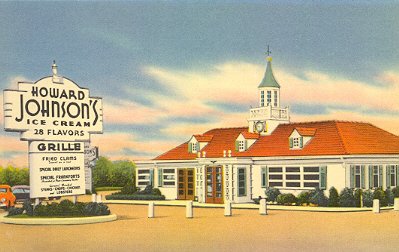 Howard Johnson restaurants and hotels once dotted the countryside, just like Starbucks are seemingly ubiquitous in Washington, DC.
Howard Johnson restaurants and hotels once dotted the countryside, just like Starbucks are seemingly ubiquitous in Washington, DC. Most of us ex-suburbanites must remember the Howard Johnson's restaurants (and motels) dotting the exit ramps of the Interstates. Don't you miss that orange roof?
If you're not from a seaboard area, chances are before Red Lobster came to your community, the first place you ever had clams was a Howard Johnson's. As Andrew Cassel, business columnist for the Philadelphia Inquirer puts it in his column, "A simple stimulus for urban development," "And just as Howard Johnson's did for cross-country motorists in the 1950s, a Starbucks in an urban neighborhood today sends an appealing signal that's good for business."
In the last few weeks, the Post and other papers have reported on a new citizen-driven effort to attract higher quality retail to Prince George's County. The article "New Group Pitches Upscale Retail," from the Gazette Newspapers, covers the sentiment pretty well--
County and business leaders have stepped up their efforts in recent years to lure high-end retailers to Prince George's County. Now a group of residents, frustrated with promises of Nordstrom and the reality of discount stores, has formed to lobby developers directly. On Monday, with Beltway Plaza -- a 900,000-square-foot Greenbelt shopping center filled with discount stores -- as a backdrop, three county residents held a news conference to launch the nonprofit Upscale Prince George's.
And while they commended County Executive Jack B. Johnson (D) and local business leaders for pursuing high-end retailers to do business in Prince George's, it's time for the county's 850,000 residents to get involved, they said. "I think the county government is doing an excellent job of leverage, but ... the results are very slow," said the Rev. Eugene A. Marriott. "We're not getting the type of turnaround time needed to address the concerns within our lifetime." (...)
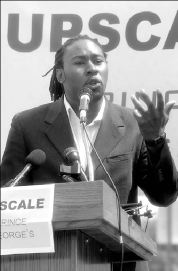 Barbara L. Salisbury/The Gazette. "We can no longer be satisfied with the status quo," said Derrick Plummer, a founding member of Upscale Prince George's, a new nonprofit trying to lure high-end retailers to the county.
Barbara L. Salisbury/The Gazette. "We can no longer be satisfied with the status quo," said Derrick Plummer, a founding member of Upscale Prince George's, a new nonprofit trying to lure high-end retailers to the county. But still no Nordstrom, Saks or Cheesecake Factory is on the immediate horizon. Another group member, Gregory Holmes, a 35-year resident of Prince George's, said he doesn't want the county to become littered with low-end retailers. "We are here to say that Prince George's would no longer be a dumping ground, and that the voice of these people matter," Holmes said. "There's a shared goal here. The goal is to start the dialogue. Our time is right now."
Even though Prince George's has the highest household income in a predominantly black county in the nation, among the factors working against it is its high crime rate, including record-setting numbers of auto thefts and homicides. Group member Derrick Plummer said that should not deter high-end retailers. "Crime is not unique to Prince George's County," Plummer said. "Crime is all around us. Crime is everywhere you go. We cannot hinder development, simply because in certain areas, there's a small number of people committing crimes in this county. "You shouldn't have to travel 20, 30 miles outside of your own community to get basic services and needs," Plummer said. "We can no longer be satisfied with the status quo."
Post columnist Mark Fisher writes about this effort in "The Bittersweet Taste of Coffee Beyond Reach." "Starbucks says its slow pace in Prince George's has nothing to do with race and everything to do with the lack of the big-box shopping centers that the chain prefers for its suburban locations. And the big boxes have stayed away because of fear of crime, developers say. Jeff Ellison, a 20-year resident of Prince George's who is Starbucks' regional director for most of Maryland, says the problem is that developers "read the paper about Landover and Suitland and they don't realize that this is the home to the most affluent African-American community, so they shy away from building big shopping centers. But that's changing."
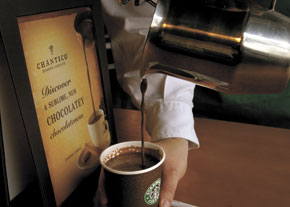 Upscale non-coffee drinks are a big component of the Starbucks marketing program. Photo by Joyce Lin/Daily Bruin (UCLA).
Upscale non-coffee drinks are a big component of the Starbucks marketing program. Photo by Joyce Lin/Daily Bruin (UCLA).Cracking the retail recruitment piece is tough. Still, people justifiably complain about the recruitment of national chains and the failure to nurture locally owned businesses. The Gazette Newspapers appear not to have done a story on Riverdale Books, a bookstore-coffee shop, which until tomorrow is across the street from the Riverdale Park MARC Train Station. They lost their lease, and while there is plenty of spaces available along Rte. 1 between Mt. Rainer and East-West Highway, instead they are "going on hiatus."
Both Fisher and Cassell discuss MapMuse and the mapping of Starbucks locations. Cassell writes "The fast-growing nationwide coffeehouse chain had become a kind of indicator of urban vitality. A Starbucks in the neighborhood suggested an upwardly mobile population and a market for residential and commercial growth."
MapMuse Starbucks locator
I think this is a particularly relevant point to PG County.
I mentioned that I interviewed for a community development manager job in that county. In preparing for the interview, it occurred to me that while the communities along Rhode Island Avenue look to DC for arts-related success and vitality (i.e., through the Gateway Arts District), they should also look to the research and creativity centered around the University of Maryland campus, and think about how to leverage that vitality going south on Rte. 1 towards the District line.
While UMD is one of the top 50 academic research institutions in the U.S., there is virtually no discussion about the "creative class" in the context of Prince George's County. Do a google search yourself with the criteria "creative class" and "prince george's county." Today, as in January, there are less than 50 hits.
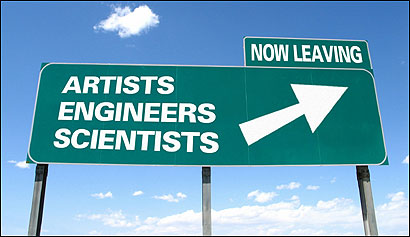 Illustration from the Boston Globe.
Illustration from the Boston Globe.Retail attraction isn't just a version of "if you build it they will come." There are a lot of factors at work.
I thought that Hyattsville should try to position the Rte. 1 corridor retail strategy vis-a-vis the greater PG effort, along the lines of independent retail business development. They have Franklin's and the John Nelson Gallery already. The new development of the old automobile dealerships would allow for larger floorplate but creative businesses like a Buffalo Billiards, bookstore-cafe, a smaller scale grocery, a Mayorga Cafe comparable to the one on Georgia Avenue etc.
More big boxes is hardly the prescription for creative vitality, and not likely to be the best way of attracting unique retail to Prince George's County.
Our counterparts in Prince George's County also need to check out the resources at www.danth.com and the National Main Street Center.
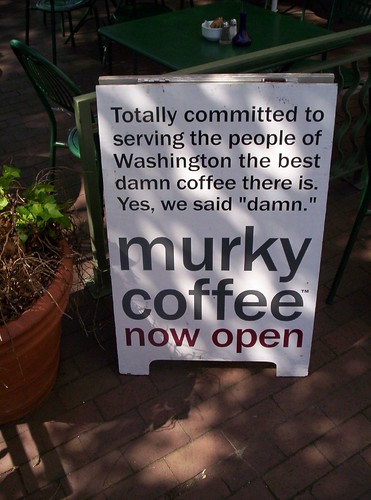 7th Street SE, Washington, DC.
7th Street SE, Washington, DC.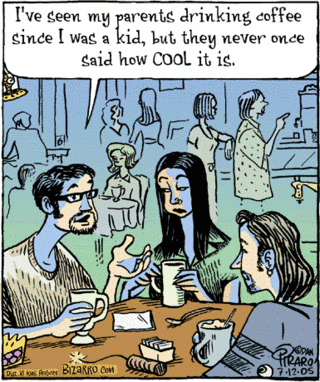 Can Upscale Prince George's make the county cool?
Can Upscale Prince George's make the county cool?



0 Comments:
Post a Comment
<< Home